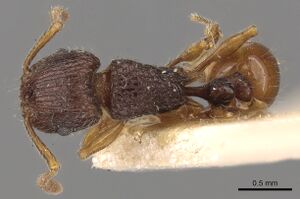Tetramorium turneri
| Tetramorium turneri | |
|---|---|

| |
| Scientific classification | |
| Kingdom: | Animalia |
| Phylum: | Arthropoda |
| Class: | Insecta |
| Order: | Hymenoptera |
| Family: | Formicidae |
| Subfamily: | Myrmicinae |
| Tribe: | Crematogastrini |
| Genus: | Tetramorium |
| Species: | T. turneri |
| Binomial name | |
| Tetramorium turneri Forel, 1902 | |
A few collections of this species were found in Radiata pine forest pitfall-traps.
Identification
Bolton (1977) - T. turneri, the first tetramoriine to be described from Australia, is apparently more closely related to Tetramorium eleates of Malaysia and Indonesia than to any other species of the tortuosum-group occurring in Australia itself.
Keys including this Species
Distribution
Latitudinal Distribution Pattern
Latitudinal Range: -17.268273° to -33.45000076°.
| North Temperate |
North Subtropical |
Tropical | South Subtropical |
South Temperate |
- Source: AntMaps
Distribution based on Regional Taxon Lists
Australasian Region: Australia (type locality).
Distribution based on AntMaps
Distribution based on AntWeb specimens
Check data from AntWeb
Countries Occupied
| Number of countries occupied by this species based on AntWiki Regional Taxon Lists. In general, fewer countries occupied indicates a narrower range, while more countries indicates a more widespread species. |

|
Estimated Abundance
| Relative abundance based on number of AntMaps records per species (this species within the purple bar). Fewer records (to the left) indicates a less abundant/encountered species while more records (to the right) indicates more abundant/encountered species. |

|
Biology
Castes
Worker
Images from AntWeb
   
| |
| Syntype of Tetramorium turneri. Worker. Specimen code casent0901040. Photographer Ryan Perry, uploaded by California Academy of Sciences. | Owned by NHMUK, London, UK. |
Nomenclature
The following information is derived from Barry Bolton's Online Catalogue of the Ants of the World.
- turneri. Tetramorium (Xiphomyrmex) turneri Forel, 1902h: 447 (w.q.) AUSTRALIA. Wheeler, G.C. & Wheeler, J. 1954d: 451 (l.). Combination in Xiphomyrmex: Viehmeyer, 1925a: 29; in Tetramorium: Bolton, 1977: 145.
Unless otherwise noted the text for the remainder of this section is reported from the publication that includes the original description.
Description
Worker
Bolton (1977) - TL 3.2-3.7, HL 0.76-0.86, HW 0.70-0.80, CI 90-95, SL 0.56-0.62, SI 75-82, PW 0.54-0.62, AL 0.90-1.02 (15 measured).
Mandibles striate; anterior clypeal margin without a median notch or impression. Median clypeal carina strong, running to the anterior margin. Frontal carinae extending back almost to the occipital corners but weakening behind the level of the eye and posteriorly not more strongly defined than the rugae occurring in that area. Antennal scrobes shallow and weak, not capable of containing the scape. Eyes situated very slightly in front of midlength of sides of head, of moderate size, maximum diameter c. 0.15-0.20. Metanotal groove feebly developed, usually very faintly impressed in profile but rarely quite distinct. In one series (Ravenshoe) some workers have a small triangular prominence mediodorsally on the anterior portion of the propodeum but this is absent in other workers of the same series and in other series examined. Propodeal spines stout and acute, metapleural lobes elongate-triangular and acute, narrow. Petiole node in dorsal view usually slightly longer than broad, the node narrow in front and much broader behind, with slightly convex sides (Fig. 65); post petiole broader than long. Head longitudinally rugulose, the individual components irregular and spaced out, with few or no anastomoses or cross-meshes, the spaces smooth and shining or with a very faint superficial shagreening or vestigial puncturation. Dorsal alitrunk irregularly and shallowly spaced-rugulose with numerous cross-meshes, the spaces even more feebly sculptured than on the head, very shining. Sides of petiole and postpetiole with some rugosity but the dorsal surfaces either completely smooth or at least with a smooth and highly polished median longitudinal strip. Gaster unsculptured. All dorsal surfaces with numerous long, fine, acute hairs, which are also present on the ventral surfaces of the femora. Colour uniform dark brown or with the gaster a lighter yellowish brown; appendages light to pale brown.
Type Material
- Syntype, worker(s), queen(s), Mackay, Queensland, Australia, Australian National Insect Collection.
References
- Bolton, B. 1977. The ant tribe Tetramoriini (Hymenoptera: Formicidae). The genus Tetramorium Mayr in the Oriental and Indo-Australian regions, and in Australia. Bulletin of the British Museum (Natural History). Entomology. 36:67-151. (page 145, Combination in Tetramorium)
- Forel, A. 1902j. Fourmis nouvelles d'Australie. Rev. Suisse Zool. 10: 405-548 (page 447, worker, queen described)
- Viehmeyer, H. 1925a. Formiciden der australischen Faunenregion. (Fortsetzung.). Entomol. Mitt. 14: 25-39 (page 29, Combination in Xiphomyrmex)
- Wheeler, G. C.; Wheeler, J. 1954d. The ant larvae of the myrmicine tribes Meranoplini, Ochetomyrmicini and Tetramoriini. Am. Midl. Nat. 52: 443-452 (page 451, larva described)
References based on Global Ant Biodiversity Informatics
- Bolton, B. "The ant tribe Tetramoriini (Hymenoptera: Formicinae. The genus Tetramorium Mayr in the Oriental and Indo-Australian regions and in Australia." Bulletin of the British Museum (National History): Entomology series 36, no. 2 (1977): 68-151.
- Osunkoya O. O., C. Polo, and A. N. Andersen. 2011. Invasion impacts on biodiversity: response of ant communities to infestation by cat's claw creeper vine, Macfadyena unguis-cati (Bignoniaceae) in subtropical Australia. Biol. Invasions 13: 2289-2302.

